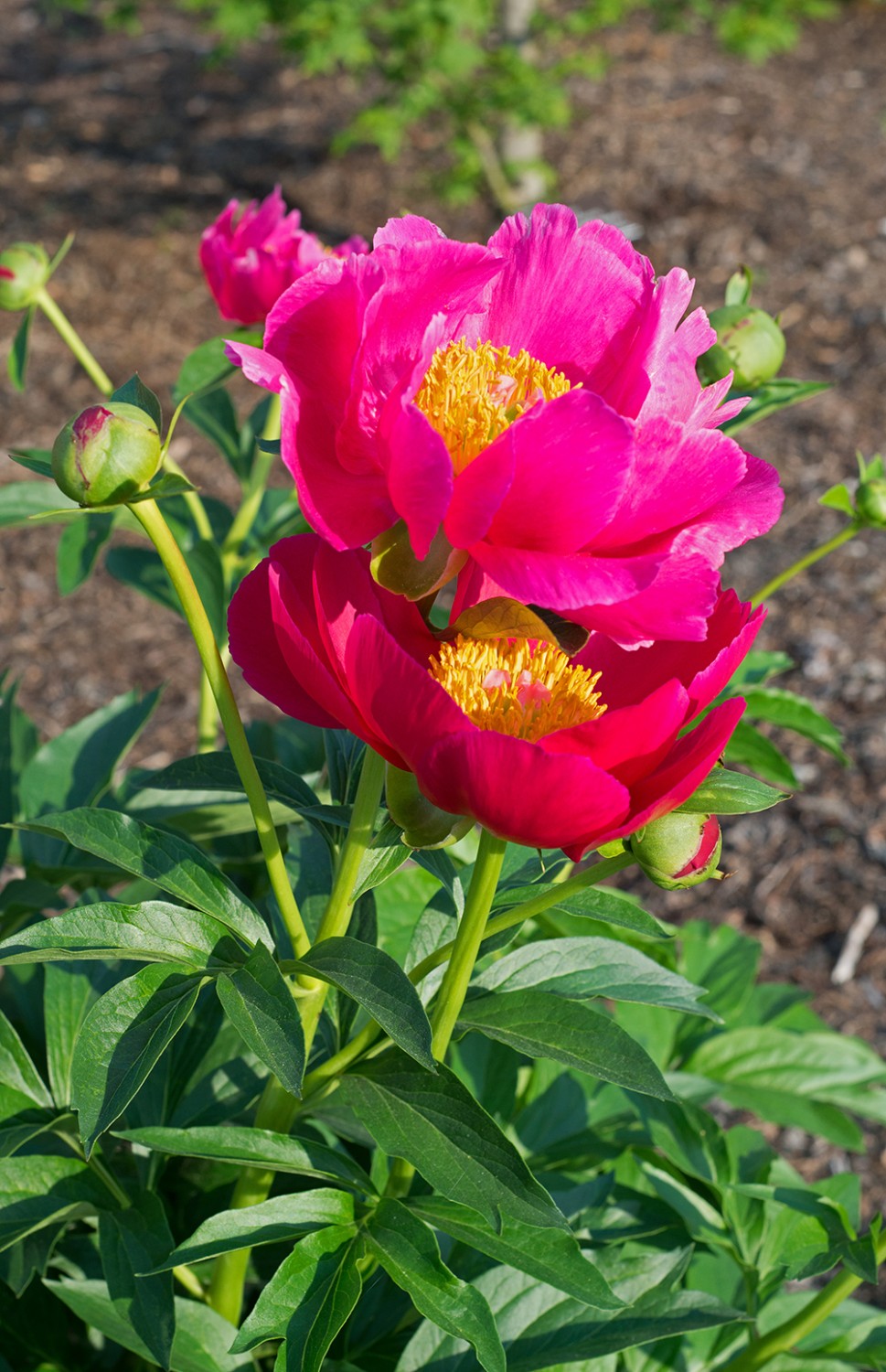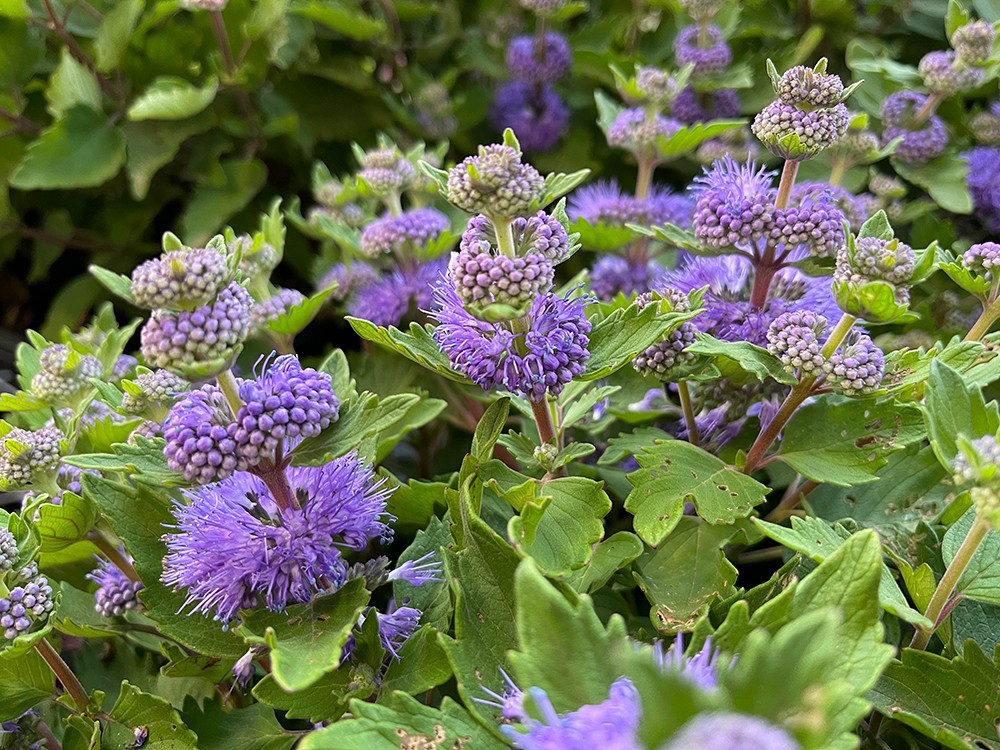Having been here long enough to feel almost indigenous, I do like most things Cary-related, and this preference has even pulled me to a particular plant. In bloom, it deserves two green thumbs up, but its name is the catch — what’s not to like about caryopteris (Caryopteris sp.)?
Also known as “bluebeard” or “blue mist,” caryopteris can provide instant as well as extended gratification with its blossoms at this time of year. Autumn is prime planting time for perennials, and it also happens to be when caryopteris flaunts its flowers with a show that easily lasts several weeks.
True to the blueness in its common names, the flowers of caryopteris are pretty blueish to purplish sprites that cluster together in cymes on stems that rise above light green foliage. White- and pink-flowering forms also exist, but, to me, they just don’t have the same elegant eye appeal.
While caryopteris is hard to miss now, when not in bloom, it is just another green blob in the landscape. However, if you prefer more visual pizzaz through the growing season, hunt for snappy cultivars such as ‘Snow Fairy,’ ‘Summer Sorbet,’ or ‘White Surprise’ that sport fancy variegated leaves. Like flashy chartreuse foliage instead? Check out ‘Worcester Gold’ or ‘Gold Crest.’ If you run across any of these selections now in a local nursery, great; otherwise, they can be found online.
An import from eastern Asia, caryopteris is reliably hardy in our area and will thrive in a sunny location, but care should be taken to plant it in proper soil because the gooey clay that is typical around here can encourage root rot to pounce on this pretty quickly. Well-draining locations such as raised gardens, rock gardens, or even large containers suit caryopteris best.
Caryopteris is drought tolerant, once established, and deer resistant. It is also maintenance light, meaning it doesn’t demand attention every time you step into the garden. As far as nutritional needs, a light application of time-release, low-nitrogen fertilizer or, even better, a generous side-dressing of compost in the spring will do just fine, thank you.
Some caryopteris cultivars can top out at about 3 feet high and wide, but pruning in the early spring each year will help keep them to the size you prefer in your landscape. This early stem snipping also has the advantage of encouraging more blooms, since flowers form on new growth developed during the spring and summer.

Peony Scarlett O’Hara
September is THE month for buying and planting peony tubers. At the store, pick out the chubbiest tubers you can find that have at least four to five pinkish “eyes” on each. In the garden, don’t plant them too deep — no more than an inch below the soil’s surface. This close encounter will allow the tucked-away tubers to experience the beneficial chill of winter, which they need to develop — and bloom — properly. Also, if possible, site your peonies-to-be in an area that greets the morning sun, but is somewhat shaded from the harshest afternoon rays during the growing season.
To Do in the Garden
September
- Resist the urge to prune perennials and woodies at this time of year because such shearing now will encourage new growth in the early fall that probably won’t have time to harden off before the first frosts bite.
- It’s a busy time in the veggie garden because broccoli, arugula, Chinese cabbage, cauliflower, Swiss chard, dill, kale, lettuce, mustard greens, onions, parsley, turnips, spinach, and radishes can all be planted now.
- Before cold weather moves in, parsley, thyme, oregano, basil, mint, and chives, six easy-to-grow — as well as transplant — edibles can be dug up from the garden and placed in pots on sunny window sills for a small indoor herb garden.
- Patrol the rose bed — watch for any signs of black spot and snip off infected leaves. Since this is a soil-borne disease that can overwinter in the garden, also rake up and dispose of fallen flowers and foliage.
- Meet Cary Magazine’s 2022 Women of Western Wake
- Women of Western Wake: Karen Russell
- Women of Western Wake: Charmaine Riggins
- Women of Western Wake: Irena Krstanovic
- Women of Western Wake: Cary Heise
- Women of Western Wake: Jackie Ferguson
- Glam Soldier
- Sylvan Heights Bird Park
- Things to Do: September 2022
- On Trend: Hydrate Medical
- Soaring Into Success
- Restaurant Profile: Sushi Suyu
- Garden Adventurer: Caryopteris for Cary
- Liquid Assets: Butterfly Margarita
- Small Business Spotlight: Pura Vida Studio
- Nonprofit Spotlight: Dress For Success Triangle







